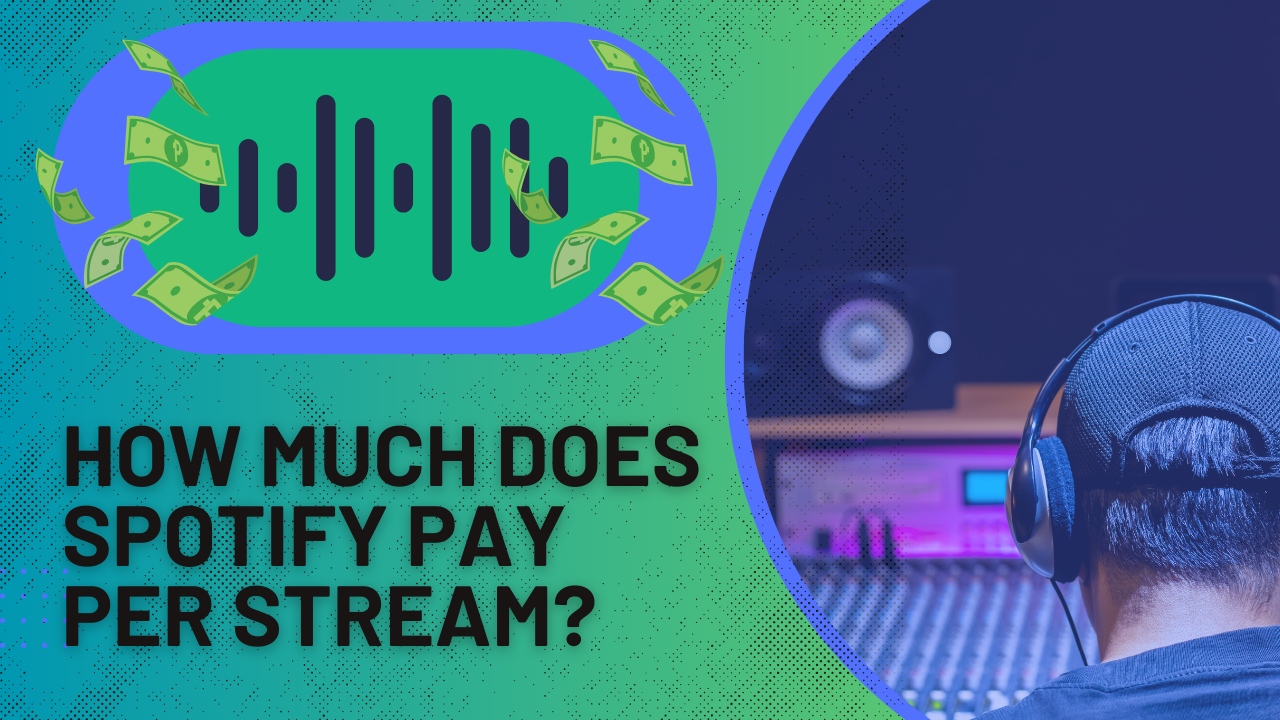Spotify is one of the most popular music streaming platforms in the world, with over 600 million users and counting. Streaming services have completely changed the way that music lovers consume their favorite tunes.
For artists, labels, and music businesses, Spotify isn’t just a way to reach fans: it’s also a way to earn money. But one question comes up over and over again:
How much does Spotify pay per stream in 2025?
The short answer: It varies. It seems like streaming royalties are super low at first glance.
But if you’re serious about making Spotify part of your income strategy, whether you’re an independent artist, record label, or digital creator, you’ll want to understand how Spotify royalty payments work, how stream counts are calculated, and what factors can influence your actual earnings.
This detailed guide covers all of that and more. Let’s break it down.
Table of Contents
How much does Spotify pay per stream?
In 2025, the Spotify streaming platform pays artists between $0.003 and $0.005 per stream on average. This means that:
- 1,000 streams = $3 to $5
- 10,000 streams = $30 to $50
- 100,000 streams = $300 to $500
- 1 million streams = $3,000 to $5,000
These are only averages for streaming income, and obviously if you can hit a million streams or more, you’ll be able to make some decent money.
This is likely someone who has a solid footing in the music industry and has been successful in launching their digital music on this and other streaming services.
Keep in mind though that artist payments and the actual amount you make per stream depends on many variables. These include things like where your listeners are located and whether they’re using a free account or paid Spotify premium.
Some streams might pay as low as $0.001, while others might hit $0.007 or more. So, as you can see, not all streams are created equal.
For example, if most of your listeners are premium users in the U.S., your payout per stream is likely on the higher end. But if most of your audience uses free accounts in lower-income countries, you’ll see generate royalties on the smaller side.
That’s why the term “pay per stream” is a simplification—Spotify uses a complex royalty system based on total revenue and your share of it, not a flat per-stream rate. They also need to factor in fake streams.
As a takeaway, the amount that Spotify pay artists is on average with the other music streaming platforms like Apple music and Soundcloud, although Soundcloud is on the lower end of the three and features more independent artists.
YouTube music streaming platform has reportedly paid the highest of them all, but it would only be about 0.001 more. Although, if you are very successful at music streaming, that small amount may add up in terms of streaming revenue.
Let’s take a look at what is considered a stream on music streaming platforms like Apple music and Spotify.
How Spotify counts streams
If you’re brand new to music online, listening to a song on music streaming platforms is called a “stream.”
Spotify specifically defines a “stream” as someone listening to your song for at least 30 seconds. If the listener skips your track before that point, it doesn’t count as a stream. You will not get music streaming payouts for listens less than 30 sec.
This is reportedly the same for most streaming services like Apple music and YouTube music.
On that note, here are a few things to know:
- Repeat listens count. If someone listens to your track multiple times, each listen (that passes 30 seconds) counts as a new stream. So, you’ll be able to earn music royalties on each of those streams.
- Short songs count too. Even if your track is 45 seconds long, it can still earn a stream if someone listens to 30+ seconds. There is no requirement on digital music length.
- Streaming in offline mode counts. When someone listens offline, their streams are recorded and reported when they go back online. This is good news since Spotify premium listeners are able to have offline playlists. Artists aiming to make money would lose out on
Example: Let’s say your fan in Germany plays your 2-minute song 10 times on repeat while working. That’s 10 streams added to your total. Recording royalties for the win!
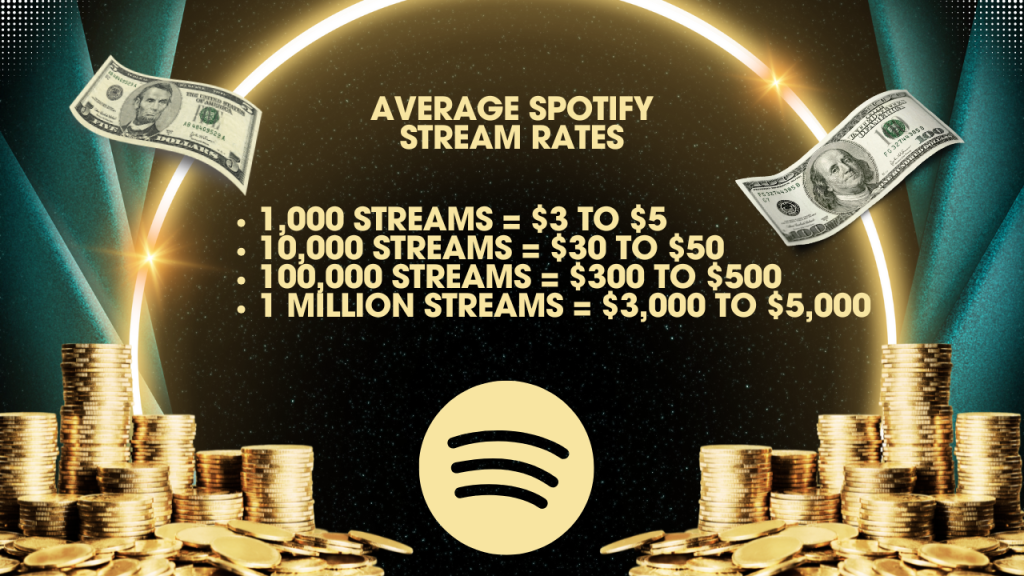
Spotify Royalty Calculator
You can estimate your Spotify revenue using a basic formula:
Number of Streams × Average Pay Rate = Estimated Earnings
Let’s use a few scenarios:
- 25,000 streams × $0.004 = $100
- 75,000 streams × $0.0035 = $262.50
- 500,000 streams × $0.0045 = $2,250
There are also online tools like Music Gateway’s Spotify Royalty Calculator or Ditto Music Royalty Calculator, which let you plug in your stream numbers for a quick estimate.
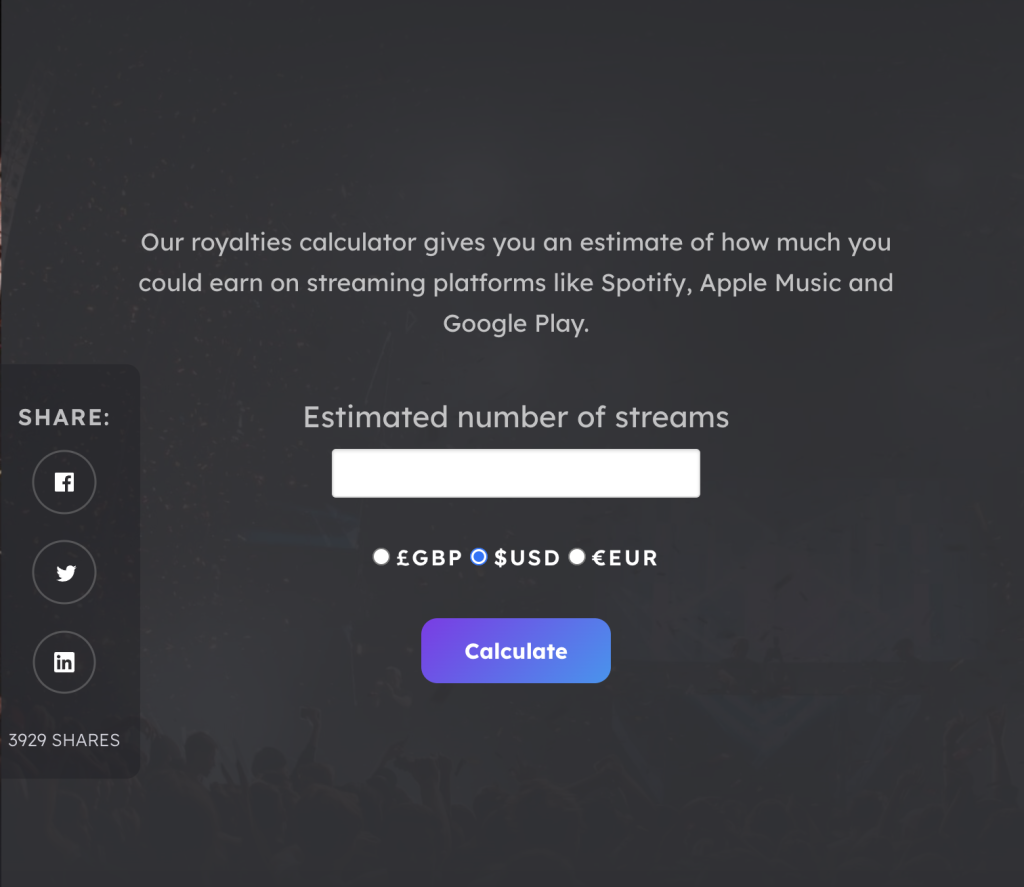
Just remember: these calculators give you a ballpark figure. The real payout is determined by your distribution deal, your audience’s geography, and Spotify’s monthly revenue pool. Music streaming payouts are pretty complex!
How do Spotify streaming payouts work?
Spotify doesn’t pay artists per stream directly. Instead, it uses a revenue share model called the pro-rata model. It can be pretty intricate, but here’s how it works in simple terms:
- Spotify collects money from monthly subscription fees (Premium users) and ads (Free users).
- Spotify takes a 30% cut for operating costs.
- The remaining 70% goes into a royalty pool.
- This royalty pool is then split among rights holders based on their share of total streams that month.
Let’s say Spotify earned $1 billion this month, and your music made up 0.01% of all streams that month. You’d be eligible for 0.01% of the $700 million royalty pool—about $70,000.
But wait—it doesn’t all go right into your pocket. Music streaming payouts are usually split among:
- Your distributor or record label (they may take 10–50%)
- Songwriters and publishers (if you’re not the sole rights holder)
- You, the artist as the rights holders
If you’re independent and using a distributor like DistroKid that doesn’t take a cut, you get more of that money.
If you’re signed to a major record label, your share could be significantly lower depending on your deal. It’s really important to understand the music industry and how music royalties work while you are negotiating a new deal or contract.
What is a Spotify ‘pay per stream’?
“Pay per stream” is a convenient phrase people use to describe Spotify payouts, but as we mentioned above, Spotify doesn’t technically pay per stream.
It’s not as simple as a flat rate like $0.004 per stream across the board.
Instead, what you’re earning is your share of Spotify’s revenue based on the percentage of total music streaming you generate in a given month. That is the same concept as explained previously.
We’ll break it down one more time. Think of it this way:
- If you generate 100,000 streams out of 10 billion total monthly streams, you earn 0.001% of the royalty pool.
- If total revenue was $800 million that month, your earnings before splits would be $8,000.
Understanding this model helps you see why your music royalties fluctuate even if your stream numbers stay the same.
What can affect Spotify royalty rates?
There are several key factors that impact how much you earn from Spotify. Let’s break them down.
1. Who you distribute with
Spotify pays royalties to music distributors, not artists directly. You’ll need a music distributor to get your music on Spotify. This is a common practice in the music world even before popular music streaming services.
Some popular distributors include:
- DistroKid – You pay an annual fee (starting at $22.99/year), but keep 100% of your royalties.
- TuneCore – Offers multiple plans; you may pay a flat fee or split a percentage of your earnings.
- CD Baby – Takes 9% of digital royalties and charges a one-time setup fee.
- Ditto Music – Takes 10% of publishing royalties and charges $19/year.
Example: If you earned $500 in royalties from Spotify:
- With DistroKid, you keep the full $500.
- With CD Baby, you get $455 (after a 9% cut).
2. Your listeners’ country of origin
Spotify earns more money from some countries than others. This directly affects your per-stream payout.
Higher-paying countries:
- United States
- United Kingdom
- Canada
- Germany
- Australia
Lower-paying countries:
- India
- Indonesia
- Brazil
- Philippines
Example:
- A stream from a U.S. premium user might be worth $0.005.
- A stream from an Indian free user might only be worth $0.001.
So, two artists with 100,000 streams could earn very different amounts depending on where their listeners are.
3. Your listeners’ Spotify account plan
Spotify has both free and paid users. Their behavior and value differ:
- Premium subscribers: Pay monthly fees. Their streams generate higher revenue.
- Free users: See ads. Their streams are worth less.
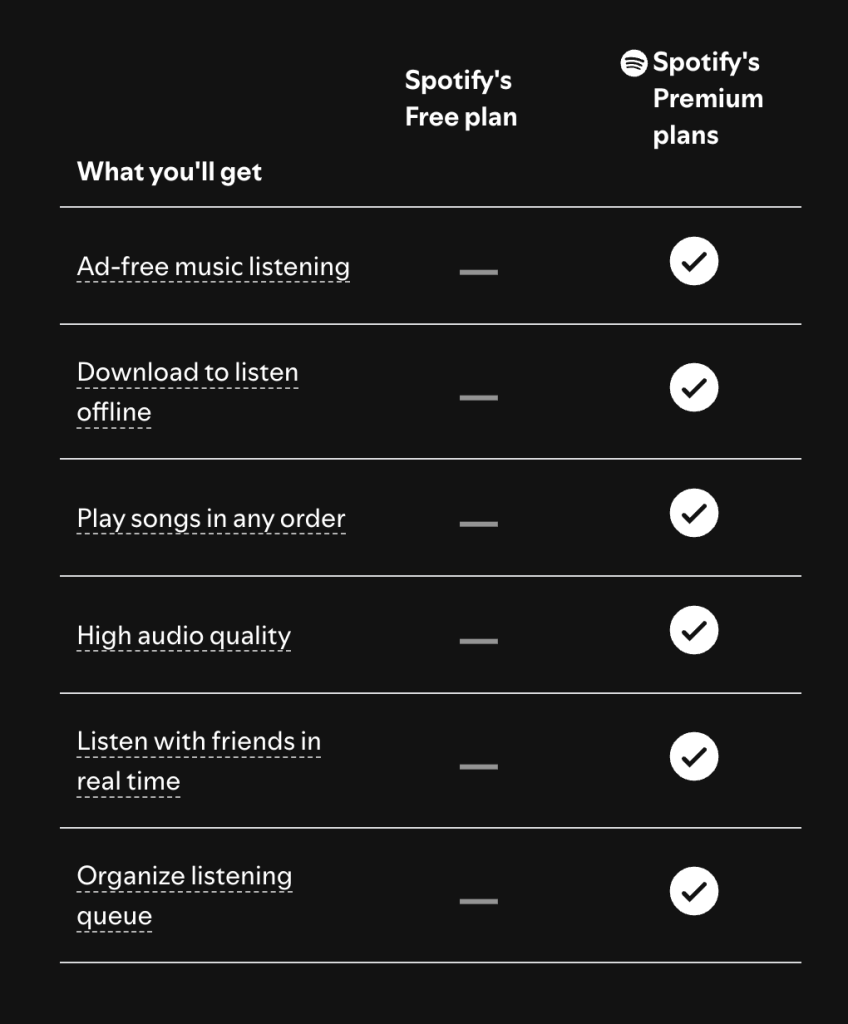
Example:
- 1,000 premium streams might pay around $4.50.
- 1,000 free streams might pay around $2.00.
If your fanbase is mostly premium listeners, your payouts will naturally be higher. Of course, this is out of your control.
Spotify announced they would be offering lossless audio soon, which is the highest quality of audio available. It’s likely if this comes into effect, all the royalties could increase because it will likely be another paid service. This isn’t confirmed yet, however.
How to earn more money through Spotify streams
Earning more from Spotify isn’t just about getting more streams—it’s about being strategic with your music, audience, and promotion. Here are some powerful tips:
1. Promote your music on social media
Platforms like TikTok, Instagram Reels, and YouTube channels or shorts are powerful for getting new eyes (and ears) on your songs. Link your Spotify profile and encourage people to stream and follow you.
Example: Share a behind-the-scenes clip or a story about your song. People love authenticity.
2. Get on Spotify playlists
Playlists drive a huge chunk of Spotify traffic. Use Spotify for Artists to pitch your songs to editorial playlists at least 7 days before release. Also, network with independent curators.
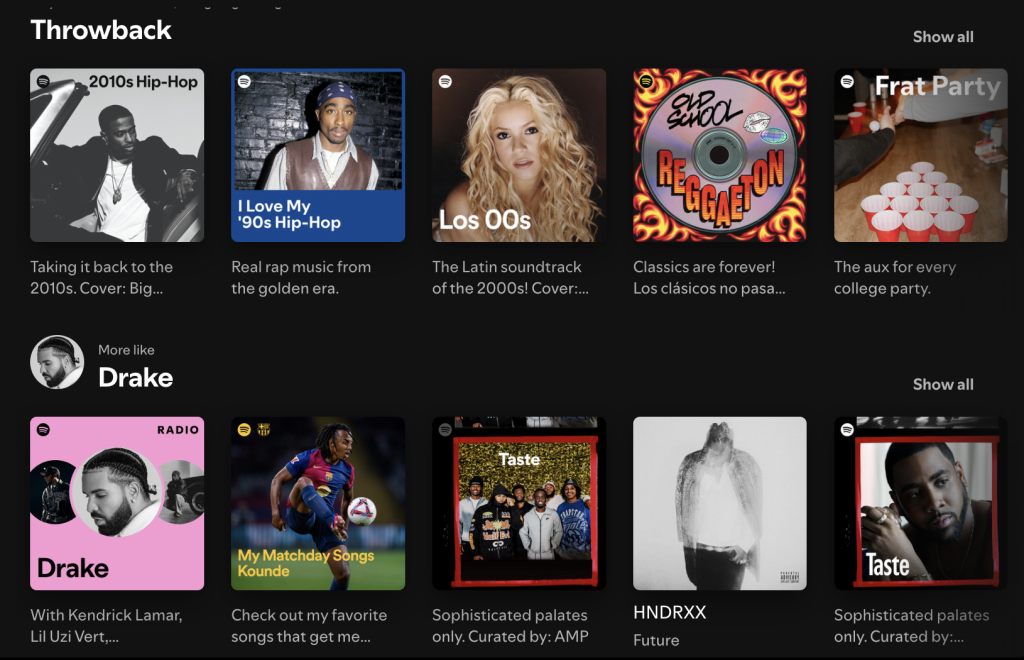
3. Release music regularly
Staying consistent helps you grow. Aim to release new music every 4 to 6 weeks, even short singles, to stay on algorithmic radars and increase streams.
4. Grow your fanbase
Ask fans to follow your artist profile and save your songs. These actions help Spotify’s algorithm recommend your music to more users.
5. Use Spotify for Artists
Check your analytics: Where are your fans located? Which songs perform best? Use this data to make smarter decisions about promotion and releases.
6. Monetize beyond streams
Streaming is just one income stream. Use your Spotify success to:
- Sell merch (via Shopify integrations)
- Book gigs or livestreams
- Launch a Patreon or Substack for fans
Treat Spotify as part of a bigger vision, not the end goal.
Takeaways: How Much Does Spotify Pay Per Stream in 2025
Here’s what you should remember about Spotify payouts in 2025:
- Spotify pays between $0.003 and $0.005 per stream, but this isn’t fixed.
- Your earnings depend on your listeners’ country, account type, and total share of Spotify streams.
- Spotify pays rights holders from a royalty pool, not a fixed rate.
- Distributors and labels take their share before you see any money.
- Streams from premium users in high-income countries pay more.
To earn more:
- Promote your music consistently.
- Get on playlists.
- Release music regularly.
- Use Spotify’s tools to analyze your data.
- Monetize your fanbase beyond just streams.
- Consider using different streaming platforms to get more streams and royalty payments.
Spotify isn’t a get-rich-quick scheme, but with the right approach, it can become a meaningful part of your income, especially when paired with a smart business strategy.
Want to grow your Spotify earnings in 2025? Start by releasing great music, engaging your fans, and using tools like Spotify for Artists to your advantage.
Treat your music like a business, and your streams like investments in your future. After all, Spotify is the biggest music streaming platform, so you should set yourself up for success!
FAQs: How Much Does Spotify Pay Per Stream
Here’s a quick glance into some questions related to Shopify and its music royalties.
How much do 1 million Spotify streams pay?
On average, 1 million streams on Spotify pays between $3,000 and $5,000. Still, the exact amount depends on who your listeners are, where they’re located, and whether they’re using free or premium accounts.
If you work with a distributor or label, they may take a portion of that payout as well. Unfortunately, artists don’t take away 100% of streaming royalties.
How many streams to make $1000 on Spotify?
To make $1,000 on Spotify, you need between 200,000 and 350,000 streams, depending on your average per-stream payout.
If most of your listeners are in high-paying countries and use premium accounts, you’ll hit that number faster. This is about the same on other streaming platforms like Apple Music and YouTube Music.
It may seem like a lot, but if you are a serious recording artist that has a solid chunk of monthly listeners and user generated playlists, you can hit that number and make a bit more money.
What is the 30 second rule on Spotify?
Spotify only counts a stream if a listener plays at least 30 seconds of your track.
If someone skips your song before the 30-second mark, it doesn’t count. This is why the first part of your song is so important! You need to grab attention early to maximize your count and earnings.
Even
How much is 500k streams on Spotify?
With 500,000 streams, you can expect to earn between $1,500 and $2,500, depending on listener location, account type, and your distribution setup. A higher percentage of premium listeners from the U.S. or UK could push that number toward the upper range.

